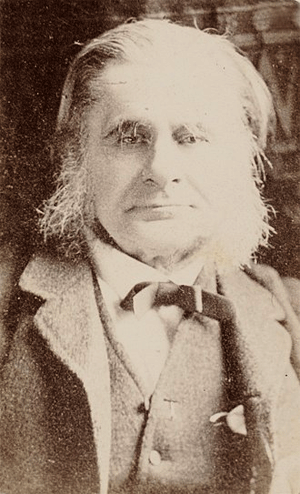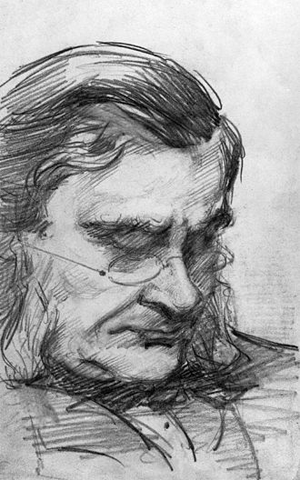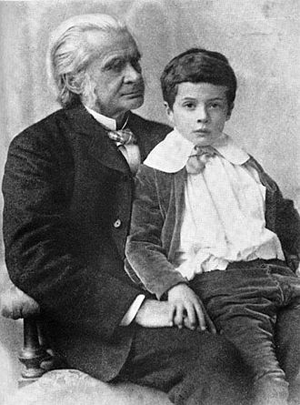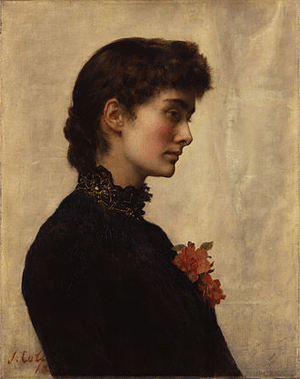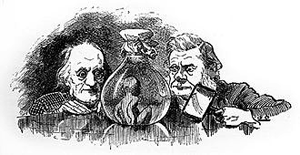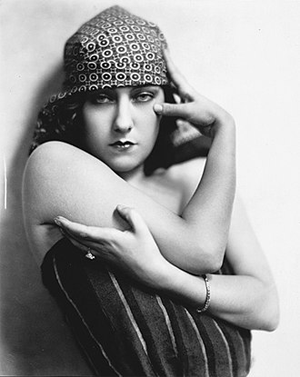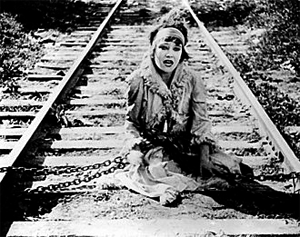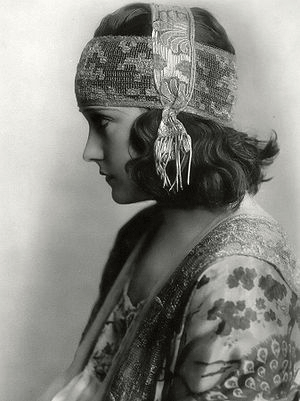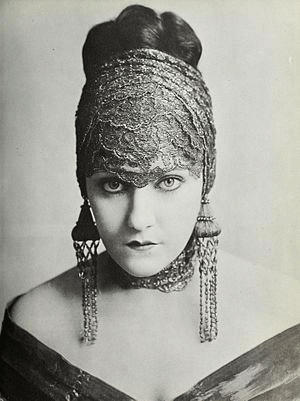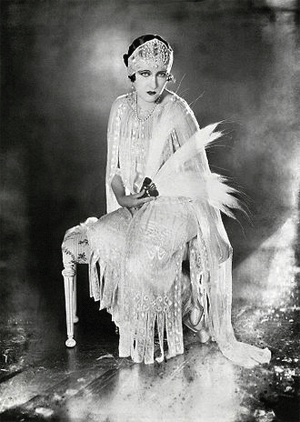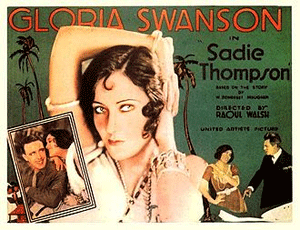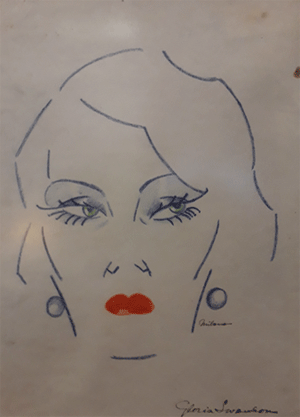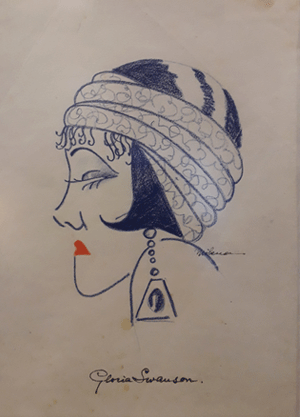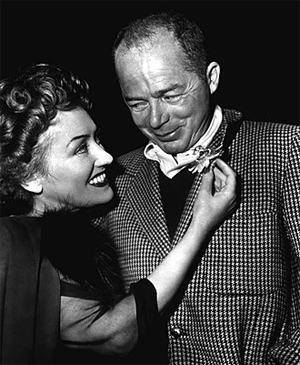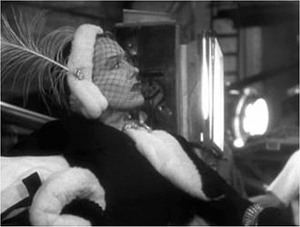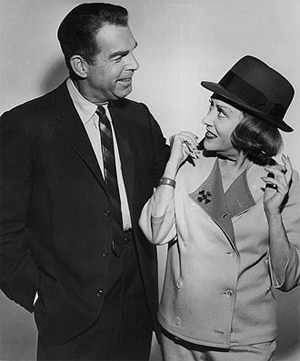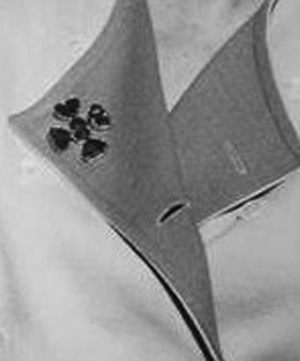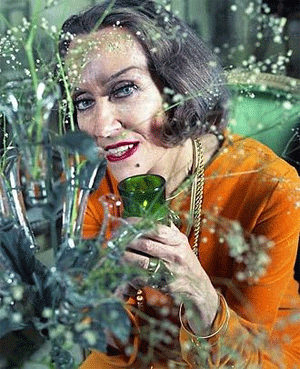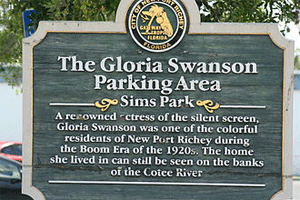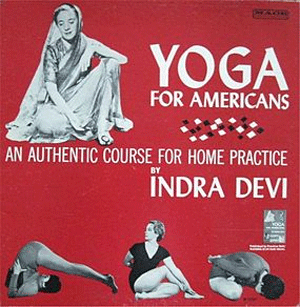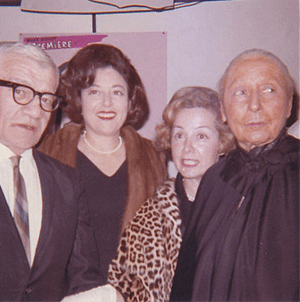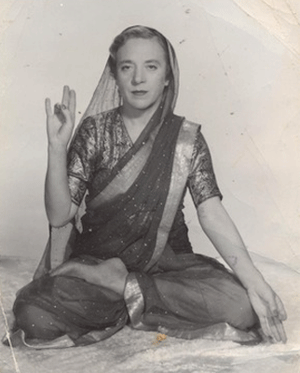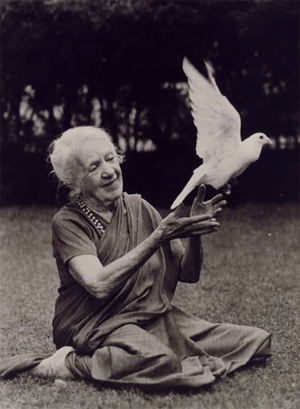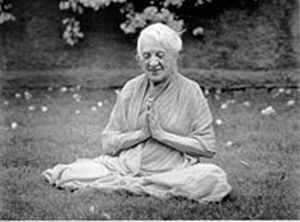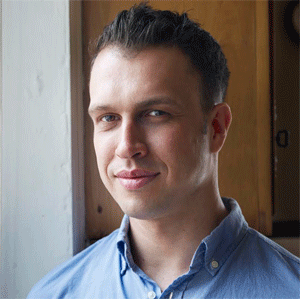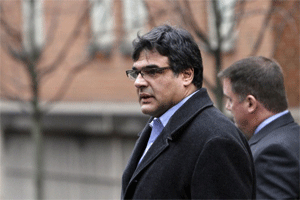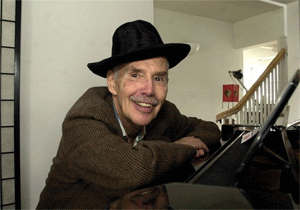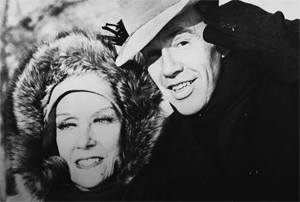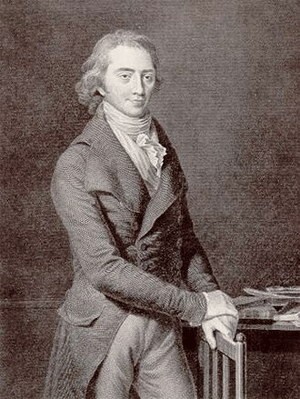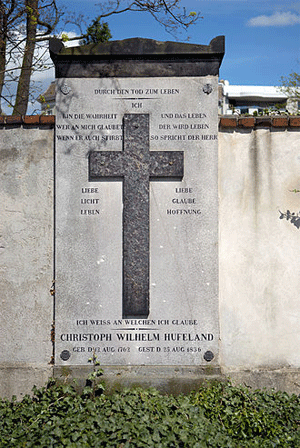Thomas Henry Huxley
by Wikipedia
Accessed: 6/21/19
NOTICE: THIS WORK MAY BE PROTECTED BY COPYRIGHT
YOU ARE REQUIRED TO READ THE COPYRIGHT NOTICE AT THIS LINK BEFORE YOU READ THE FOLLOWING WORK, THAT IS AVAILABLE SOLELY FOR PRIVATE STUDY, SCHOLARSHIP OR RESEARCH PURSUANT TO 17 U.S.C. SECTION 107 AND 108. IN THE EVENT THAT THE LIBRARY DETERMINES THAT UNLAWFUL COPYING OF THIS WORK HAS OCCURRED, THE LIBRARY HAS THE RIGHT TO BLOCK THE I.P. ADDRESS AT WHICH THE UNLAWFUL COPYING APPEARED TO HAVE OCCURRED. THANK YOU FOR RESPECTING THE RIGHTS OF COPYRIGHT OWNERS.
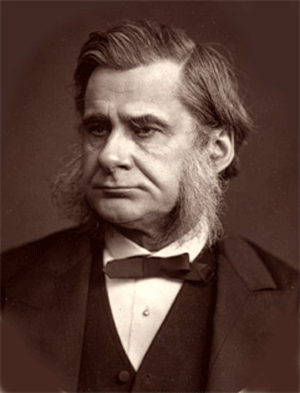
The Right Honourable
Thomas Henry Huxley
FRS FLS
Woodburytype print of Huxley (1880 or earlier)
Born 4 May 1825
Ealing, London, Middlesex, England
Died 29 June 1895 (aged 70)
Eastbourne, Sussex, England
Residence London
Nationality English
Citizenship United Kingdom
Education Sydenham College, London[1]
Charing Cross Hospital
Known for Evolution, science education, agnosticism
Awards Royal Medal (1852)
Wollaston Medal (1876)
Clarke Medal (1880)
Copley Medal (1888)
Linnean Medal (1890)
Hayden Memorial Geological Award (1893)
Scientific career
Fields Zoology; comparative anatomy
Institutions Royal Navy, Royal College of Surgeons, Royal School of Mines, Royal Institution University of London
Academic advisors Thomas Wharton Jones
Notable students Michael Foster
H. G. Wells
Influences Edward Forbes
Charles Darwin
Influenced Patrick Geddes
Henry Fairfield Osborn
H. G. Wells
E. Ray Lankester
William Henry Flower
Aldous Huxley
Julian Huxley
Thomas Henry Huxley PC FRS HonFRSE FLS (4 May 1825 – 29 June 1895) was an English biologist and anthropologist specialising in comparative anatomy. He is known as "Darwin's Bulldog" for his advocacy of Charles Darwin's theory of evolution.[2]
The stories regarding Huxley's famous debate in 1860 with Samuel Wilberforce were a key moment in the wider acceptance of evolution and in his own career, although historians think that the surviving story of the debate is a later fabrication.[3] Huxley had been planning to leave Oxford on the previous day, but, after an encounter with Robert Chambers, the author of Vestiges, he changed his mind and decided to join the debate. Wilberforce was coached by Richard Owen, against whom Huxley also debated about whether humans were closely related to apes.
Huxley was slow to accept some of Darwin's ideas, such as gradualism, and was undecided about natural selection, but despite this he was wholehearted in his public support of Darwin. Instrumental in developing scientific education in Britain, he fought against the more extreme versions of religious tradition.
Originally coining the term in 1869, Huxley elaborated on "agnosticism" in 1889 to frame the nature of claims in terms of what is knowable and what is not. Huxley states
Agnosticism, in fact, is not a creed, but a method, the essence of which lies in the rigorous application of a single principle... the fundamental axiom of modern science... In matters of the intellect, follow your reason as far as it will take you, without regard to any other consideration... In matters of the intellect, do not pretend that conclusions are certain which are not demonstrated or demonstrable.[4]
Use of that term has continued to the present day (see Thomas Henry Huxley and agnosticism).[5] Much of Huxley's agnosticism is influenced by Kantian views on human perception and the ability to rely on rational evidence rather than belief systems.[6]
Huxley had little formal schooling and was virtually self-taught. He became perhaps the finest comparative anatomist of the later 19th century.[7] He worked on invertebrates, clarifying relationships between groups previously little understood. Later, he worked on vertebrates, especially on the relationship between apes and humans. After comparing Archaeopteryx with Compsognathus, he concluded that birds evolved from small carnivorous dinosaurs, a theory widely accepted today.
The tendency has been for this fine anatomical work to be overshadowed by his energetic and controversial activity in favour of evolution, and by his extensive public work on scientific education, both of which had significant effects on society in Britain and elsewhere.[8][9] Huxley’s 1893 Romanes Lecture, “Evolution and Ethics” is exceedingly influential in China; the Chinese translation of Huxley’s lecture even transformed the Chinese translation of Darwin’s Origin of Species.[10]
Early life
Thomas Henry Huxley was born in Ealing, which was then a village in Middlesex. He was the second youngest of eight children of George Huxley and Rachel Withers. Like some other British scientists of the nineteenth century such as Alfred Russel Wallace, Huxley was brought up in a literate middle-class family which had fallen on hard times. His father was a mathematics teacher at Ealing School until it closed,[11] putting the family into financial difficulties. As a result, Thomas left school at age 10, after only two years of formal schooling. Huxley's parents were Anglicans, although it was against organized religion Huxley sympathized with the town's Nonconformist.[12][13]
Despite this unenviable start, Huxley was determined to educate himself. He became one of the great autodidacts of the nineteenth century. At first he read Thomas Carlyle, James Hutton's Geology, and Hamilton's Logic. In his teens he taught himself German, eventually becoming fluent and used by Charles Darwin as a translator of scientific material in German. He learned Latin, and enough Greek to read Aristotle in the original.
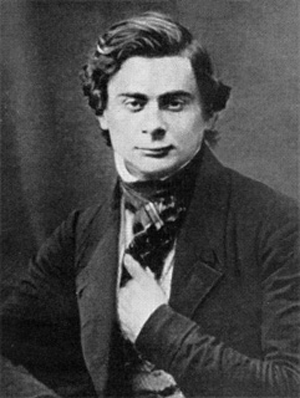
Huxley, aged 21
Later on, as a young adult, he made himself an expert, first on invertebrates, and later on vertebrates, all self-taught. He was skilled in drawing and did many of the illustrations for his publications on marine invertebrates. In his later debates and writing on science and religion his grasp of theology was better than most of his clerical opponents. Huxley, a boy who left school at ten, became one of the most knowledgeable men in Britain.[14][15]
He was apprenticed for short periods to several medical practitioners: at 13 to his brother-in-law John Cooke in Coventry, who passed him on to Thomas Chandler, notable for his experiments using mesmerism for medical purposes. Chandler's practice was in London's Rotherhithe amidst the squalor endured by the Dickensian poor. Here Thomas would have seen poverty, crime and rampant disease at its worst.[16] Next, another brother-in-law took him on: John Salt, his eldest sister's husband. Now 16, Huxley entered Sydenham College (behind University College Hospital), a cut-price anatomy school whose founder, Marshall Hall, discovered the reflex arc. All this time Huxley continued his programme of reading, which more than made up for his lack of formal schooling.
A year later, buoyed by excellent results and a silver medal prize in the Apothecaries' yearly competition, Huxley was admitted to study at Charing Cross Hospital, where he obtained a small scholarship. At Charing Cross, he was taught by Thomas Wharton Jones, Professor of Ophthalmic Medicine and Surgery at University College London. Jones had been Robert Knox's assistant when Knox bought cadavers from Burke and Hare.[17] The young Wharton Jones, who acted as go-between, was exonerated of crime, but thought it best to leave Scotland. He was a fine teacher, up-to-date in physiology and also an ophthalmic surgeon. In 1845, under Wharton Jones' guidance, Huxley published his first scientific paper demonstrating the existence of a hitherto unrecognised layer in the inner sheath of hairs, a layer that has been known since as Huxley's layer. No doubt remembering this, and of course knowing his merit, later in life Huxley organised a pension for his old tutor.
At twenty he passed his First M.B. examination at the University of London, winning the gold medal for anatomy and physiology. However, he did not present himself for the final (Second M.B.) exams and consequently did not qualify with a university degree. His apprenticeships and exam results formed a sufficient basis for his application to the Royal Navy.[14][15]
Voyage of the Rattlesnake
Aged 20, Huxley was too young to apply to the Royal College of Surgeons for a licence to practise, yet he was 'deep in debt'.[18] So, at a friend's suggestion, he applied for an appointment in the Royal Navy. He had references on character and certificates showing the time spent on his apprenticeship and on requirements such as dissection and pharmacy. Sir William Burnett, the Physician General of the Navy, interviewed him and arranged for the College of Surgeons to test his competence (by means of a viva voce).
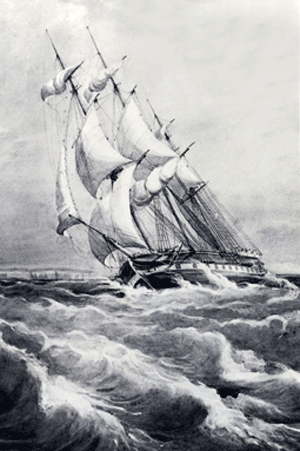
HMS Rattlesnake by the ship's artist Oswald Brierly
Finally Huxley was made Assistant Surgeon ('surgeon's mate', but in practice marine naturalist) to HMS Rattlesnake, about to set sail on a voyage of discovery and surveying to New Guinea and Australia. The Rattlesnake left England on 3 December 1846 and, once they had arrived in the southern hemisphere, Huxley devoted his time to the study of marine invertebrates.[19] He began to send details of his discoveries back to England, where publication was arranged by Edward Forbes FRS (who had also been a pupil of Knox). Both before and after the voyage Forbes was something of a mentor to Huxley.
Huxley's paper "On the anatomy and the affinities of the family of Medusae" was published in 1849 by the Royal Society in its Philosophical Transactions. Huxley united the Hydroid and Sertularian polyps with the Medusae to form a class to which he subsequently gave the name of Hydrozoa. The connection he made was that all the members of the class consisted of two cell layers, enclosing a central cavity or stomach. This is characteristic of the phylum now called the Cnidaria. He compared this feature to the serous and mucous structures of embryos of higher animals. When at last he got a grant from the Royal Society for the printing of plates, Huxley was able to summarise this work in The Oceanic Hydrozoa, published by the Ray Society in 1859.[20][21]
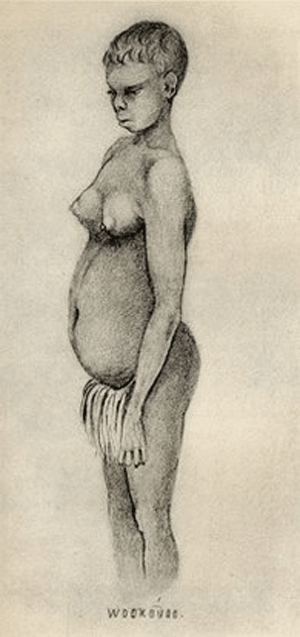
Australian woman: Pencil drawing by Huxley
The value of Huxley's work was recognised and, on returning to England in 1850, he was elected a Fellow of the Royal Society. In the following year, at the age of twenty-six, he not only received the Royal Society Medal but was also elected to the Council. He met Joseph Dalton Hooker and John Tyndall,[22] who remained his lifelong friends. The Admiralty retained him as a nominal assistant-surgeon, so he might work on the specimens he collected and the observations he made during the voyage of the Rattlesnake. He solved the problem of Appendicularia, whose place in the animal kingdom Johannes Peter Müller had found himself wholly unable to assign. It and the Ascidians are both, as Huxley showed, tunicates, today regarded as a sister group to the vertebrates in the phylum Chordata.[23] Other papers on the morphology of the cephalopods and on brachiopods and rotifers are also noteworthy.[14][15][24] The Rattlesnake's official naturalist, John MacGillivray, did some work on botany, and proved surprisingly good at notating Australian aboriginal languages. He wrote up the voyage in the standard Victorian two volume format.[25]
Later life
Huxley effectively resigned from the navy (by refusing to return to active service) and, in July 1854, he became Professor of Natural History at the Royal School of Mines and naturalist to the British Geological Survey in the following year. In addition, he was Fullerian Professor at the Royal Institution 1855–58 and 1865–67; Hunterian Professor at the Royal College of Surgeons 1863–69; President of the British Association for the Advancement of Science 1869–1870; President of the Quekett Microscopical Club 1878; President of the Royal Society 1883–85; Inspector of Fisheries 1881–85; and President of the Marine Biological Association 1884–1890.[15]
The thirty-one years during which Huxley occupied the chair of natural history at the Royal School of Mines included work on vertebrate palaeontology and on many projects to advance the place of science in British life. Huxley retired in 1885, after a bout of depressive illness which started in 1884. He resigned the presidency of the Royal Society in mid-term, the Inspectorship of Fisheries, and his chair (as soon as he decently could) and took six months' leave. His pension was a fairly handsome £1200 a year.[26]
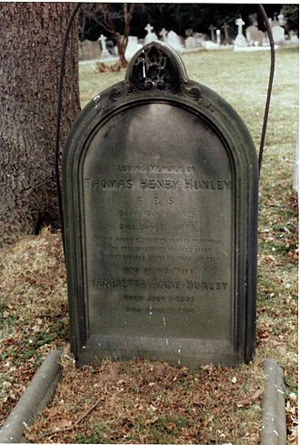
Huxley's grave
In 1890, he moved from London to Eastbourne where he edited the nine volumes of his Collected Essays. In 1894 he heard of Eugene Dubois' discovery in Java of the remains of Pithecanthropus erectus (now known as Homo erectus). Finally, in 1895, he died of a heart attack (after contracting influenza and pneumonia), and was buried in North London at St Marylebone. This small family plot had been purchased upon the death of his beloved youngest son Noel, who died of scarlet fever in 1860; Huxley's wife Henrietta Anne née Heathorn and son Noel are also buried there. No invitations were sent out, but two hundred people turned up for the ceremony; they included Joseph Dalton Hooker, William Henry Flower, Mulford B. Foster, Edwin Lankester, Joseph Lister and, apparently, Henry James.[27]
Huxley and his wife had five daughters and three sons:
Noel Huxley (1856–1860), died aged 4.
Jessie Oriana Huxley (1856–1927), married architect Fred Waller in 1877.
Marian Huxley (1859–1887), married artist John Collier in 1879.
Leonard Huxley (1860–1933), married Julia Arnold.
Rachel Huxley (1862–1934), married civil engineer Alfred Eckersley in 1884.
Henrietta (Nettie) Huxley (1863–1940), married Harold Roller, travelled Europe as a singer.
Henry Huxley (1865–1946), became a fashionable general practitioner in London.
Ethel Huxley (1866–1941) married artist John Collier (widower of sister) in 1889.
Public duties and awards
From 1870 onwards, Huxley was to some extent drawn away from scientific research by the claims of public duty. He served on eight Royal Commissions, from 1862 to 1884. From 1871 to 1880 he was a Secretary of the Royal Society and from 1883 to 1885 he was president. He was president of the Geological Society from 1868 to 1870. In 1870, he was president of the British Association at Liverpool and, in the same year was elected a member of the newly constituted London School Board. He was president of the Quekett Microscopical Club from 1877 to 1879. He was the leading person amongst those who reformed the Royal Society, persuaded government about science, and established scientific education in British schools and universities.[28] Before him, science was mostly a gentleman's occupation; after him, science was a profession.[29]
He was awarded the highest honours then open to British men of science. The Royal Society, who had elected him as Fellow when he was 25 (1851), awarded him the Royal Medal the next year (1852), a year before Charles Darwin got the same award. He was the youngest biologist to receive such recognition. Then later in life came the Copley Medal in 1888 and the Darwin Medal in 1894; the Geological Society awarded him the Wollaston Medal in 1876; the Linnean Society awarded him the Linnean Medal in 1890. There were many other elections and appointments to eminent scientific bodies; these and his many academic awards are listed in the Life and Letters. He turned down many other appointments, notably the Linacre chair in zoology at Oxford and the Mastership of University College, Oxford.[30]
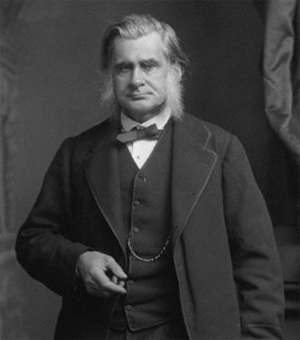
Huxley by Bassano c. 1883
In 1873 the King of Sweden made Huxley, Hooker and Tyndall Knights of the Order of the Polar Star: they could wear the insignia but not use the title in Britain.[31] Huxley collected many honorary memberships of foreign societies, academic awards and honorary doctorates from Britain and Germany. He also became foreign member of the Royal Netherlands Academy of Arts and Sciences in 1892.[32]
As recognition of his many public services he was given a pension by the state, and was appointed Privy Councillor in 1892.
Despite his many achievements he was given no award by the British state until late in life. In this he did better than Darwin, who got no award of any kind from the state. (Darwin's proposed knighthood was vetoed by ecclesiastical advisers, including Wilberforce)[33] Perhaps Huxley had commented too often on his dislike of honours, or perhaps his many assaults on the traditional beliefs of organised religion made enemies in the establishment—he had vigorous debates in print with Benjamin Disraeli, William Ewart Gladstone and Arthur Balfour, and his relationship with Lord Salisbury was less than tranquil.[15][34]
Huxley was for about thirty years evolution's most effective advocate, and for some Huxley was "the premier advocate of science in the nineteenth century [for] the whole English-speaking world".[35]
Though he had many admirers and disciples, his retirement and later death left British zoology somewhat bereft of leadership. He had, directly or indirectly, guided the careers and appointments of the next generation, but none were of his stature. The loss of Francis Balfour in 1882, climbing the Alps just after he was appointed to a chair at Cambridge, was a tragedy. Huxley thought he was "the only man who can carry out my work": the deaths of Balfour and W. K. Clifford were "the greatest losses to science in our time".[15]
Vertebrate palaeontology
The first half of Huxley's career as a palaeontologist is marked by a rather strange predilection for 'persistent types', in which he seemed to argue that evolutionary advancement (in the sense of major new groups of animals and plants) was rare or absent in the Phanerozoic. In the same vein, he tended to push the origin of major groups such as birds and mammals back into the Palaeozoic era, and to claim that no order of plants had ever gone extinct.[citation needed]
Much paper has been consumed by historians of science ruminating on this strange and somewhat unclear idea.[36] Huxley was wrong to pitch the loss of orders in the Phanerozoic as low as 7%, and he did not estimate the number of new orders which evolved. Persistent types sat rather uncomfortably next to Darwin's more fluid ideas; despite his intelligence, it took Huxley a surprisingly long time to appreciate some of the implications of evolution. However, gradually Huxley moved away from this conservative style of thinking as his understanding of palaeontology, and the discipline itself, developed.[citation needed]
Huxley's detailed anatomical work was, as always, first-rate and productive. His work on fossil fish shows his distinctive approach: whereas pre-Darwinian naturalists collected, identified and classified, Huxley worked mainly to reveal the evolutionary relationships between groups.[citation needed]
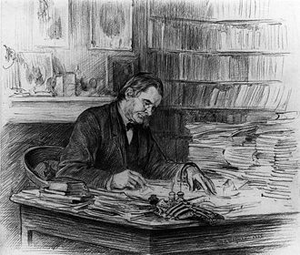
Huxley by Wirgman, a drawing in pencil, 1882
The lobed-finned fish (such as coelacanths and lung fish) have paired appendages whose internal skeleton is attached to the shoulder or pelvis by a single bone, the humerus or femur. His interest in these fish brought him close to the origin of tetrapods, one of the most important areas of vertebrate palaeontology.[37][38][39]
The study of fossil reptiles led to his demonstrating the fundamental affinity of birds and reptiles, which he united under the title of Sauropsida. His papers on Archaeopteryx and the origin of birds were of great interest then and still are.[24][40][41]
Apart from his interest in persuading the world that man was a primate, and had descended from the same stock as the apes, Huxley did little work on mammals, with one exception. On his tour of America Huxley was shown the remarkable series of fossil horses, discovered by O. C. Marsh, in Yale's Peabody Museum.[42][43] Marsh was part palaeontologist, part robber baron, a man who had hunted buffalo and met Red Cloud (in 1874). Funded by his uncle George Peabody, Marsh had made some remarkable discoveries: the huge Cretaceous aquatic bird Hesperornis, and the dinosaur footprints along the Connecticut River were worth the trip by themselves, but the horse fossils were really special.[according to whom?]
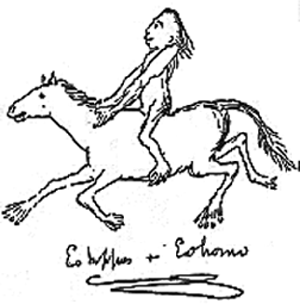
Huxley's sketch of then hypothetical five-toed Eohippus being ridden by "Eohomo"
The collection at that time went from the small four-toed forest-dwelling Orohippus from the Eocene through three-toed species such as Miohippus to species more like the modern horse. By looking at their teeth he could see that, as the size grew larger and the toes reduced, the teeth changed from those of a browser to those of a grazer. All such changes could be explained by a general alteration in habitat from forest to grassland.[citation needed] And, it is now known, that is what did happen over large areas of North America from the Eocene to the Pleistocene: the ultimate causative agent was global temperature reduction (see Paleocene–Eocene Thermal Maximum). The modern account of the evolution of the horse has many other members, and the overall appearance of the tree of descent is more like a bush than a straight line.
The horse series also strongly suggested that the process was gradual, and that the origin of the modern horse lay in North America, not in Eurasia. If so, then something must have happened to horses in North America, since none were there when Europeans arrived. The experience was enough for Huxley to give credence to Darwin's gradualism, and to introduce the story of the horse into his lecture series.[citation needed]
Darwin's bulldog
See also: Reaction to Darwin's theory
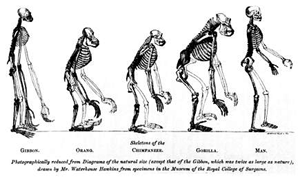
The frontispiece to Huxley's Evidence as to Man's Place in Nature (1863): the image compares the skeletons of apes to humans. The gibbon (left) is double size.
Huxley was originally not persuaded of "development theory", as evolution was once called. This can be seen in his savage review[44] of Robert Chambers' Vestiges of the Natural History of Creation, a book which contained some quite pertinent arguments in favour of evolution. Huxley had also rejected Lamarck's theory of transmutation, on the basis that there was insufficient evidence to support it. All this scepticism was brought together in a lecture to the Royal Institution,[45] which made Darwin anxious enough to set about an effort to change young Huxley's mind. It was the kind of thing Darwin did with his closest scientific friends, but he must have had some particular intuition about Huxley, who was from all accounts a most impressive person even as a young man.[46][47]
Huxley was therefore one of the small group who knew about Darwin's ideas before they were published (the group included Joseph Dalton Hooker and Charles Lyell). The first publication by Darwin of his ideas came when Wallace sent Darwin his famous paper on natural selection, which was presented by Lyell and Hooker to the Linnean Society in 1858 alongside excerpts from Darwin's notebook and a Darwin letter to Asa Gray.[48][49] Huxley's famous response to the idea of natural selection was "How extremely stupid not to have thought of that!"[50] However, he never conclusively made up his mind about whether natural selection was the main method for evolution, though he did admit it was a hypothesis which was a good working basis.
Logically speaking, the prior question was whether evolution had taken place at all. It is to this question that much of Darwin's On the Origin of Species was devoted. Its publication in 1859 completely convinced Huxley of evolution and it was this and no doubt his admiration of Darwin's way of amassing and using evidence that formed the basis of his support for Darwin in the debates that followed the book's publication.
Huxley's support started with his anonymous favourable review of the Origin in the Times for 26 December 1859,[51] and continued with articles in several periodicals, and in a lecture at the Royal Institution in February 1860.[52] At the same time, Richard Owen, whilst writing an extremely hostile anonymous review of the Origin in the Edinburgh Review,[53] also primed Samuel Wilberforce who wrote one in the Quarterly Review, running to 17,000 words.[54] The authorship of this latter review was not known for sure until Wilberforce's son wrote his biography. So it can be said that, just as Darwin groomed Huxley, so Owen groomed Wilberforce; and both the proxies fought public battles on behalf of their principals as much as themselves. Though we do not know the exact words of the Oxford debate, we do know what Huxley thought of the review in the Quarterly:
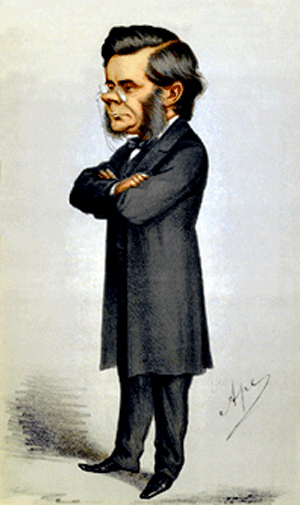
Caricature of Huxley by Carlo Pellegrini in Vanity Fair 1871
Since Lord Brougham assailed Dr Young, the world has seen no such specimen of the insolence of a shallow pretender to a Master in Science as this remarkable production, in which one of the most exact of observers, most cautious of reasoners, and most candid of expositors, of this or any other age, is held up to scorn as a "flighty" person, who endeavours "to prop up his utterly rotten fabric of guess and speculation," and whose "mode of dealing with nature" is reprobated as "utterly dishonourable to Natural Science."
If I confine my retrospect of the reception of the Origin of Species to a twelvemonth, or thereabouts, from the time of its publication, I do not recollect anything quite so foolish and unmannerly as the Quarterly Review article...[55][56]
Huxley said "I am Darwin's bulldog". While the second half of Darwin's life was lived mainly within his family, the younger combative Huxley operated mainly out in the world at large. A letter from Huxley to Ernst Haeckel (2 November 1871) states: "The dogs have been snapping at [Darwin's] heels too much of late." At Oxford and Cambridge Universities, "Bulldog" was and still is student slang for a university policeman, whose job was to corral errant students and maintain their moral rectitude.
Debate with Wilberforce
Main article: 1860 Oxford evolution debate
Famously, Huxley responded to Wilberforce in the debate at the British Association meeting, on Saturday 30 June 1860 at the Oxford University Museum. Huxley's presence there had been encouraged on the previous evening when he met Robert Chambers, the Scottish publisher and author of "Vestiges", who was walking the streets of Oxford in a dispirited state, and begged for assistance. The debate followed the presentation of a paper by John William Draper, and was chaired by Darwins's former botany tutor John Stevens Henslow. Darwin's theory was opposed by the Lord Bishop of Oxford, Samuel Wilberforce, and those supporting Darwin included Huxley and their mutual friends Hooker and Lubbock. The platform featured Brodie and Professor Beale, and Robert FitzRoy, who had been captain of HMS Beagle during Darwin's voyage, spoke against Darwin.[57]
Wilberforce had a track record against evolution as far back as the previous Oxford B.A. meeting in 1847 when he attacked Chambers' Vestiges. For the more challenging task of opposing the Origin, and the implication that man descended from apes, he had been assiduously coached by Richard Owen—Owen stayed with him the night before the debate.[58] On the day Wilberforce repeated some of the arguments from his Quarterly Review article (written but not yet published), then ventured onto slippery ground. His famous jibe at Huxley (as to whether Huxley was descended from an ape on his mother's side or his father's side) was probably unplanned, and certainly unwise. Huxley's reply to the effect that he would rather be descended from an ape than a man who misused his great talents to suppress debate—the exact wording is not certain—was widely recounted in pamphlets and a spoof play.
The letters of Alfred Newton include one to his brother giving an eyewitness account of the debate, and written less than a month afterwards.[59] Other eyewitnesses, with one or two exceptions (Hooker especially thought he had made the best points), give similar accounts, at varying dates after the event.[60] The general view was and still is that Huxley got much the better of the exchange though Wilberforce himself thought he had done quite well. In the absence of a verbatim report differing perceptions are difficult to judge fairly; Huxley wrote a detailed account for Darwin, a letter which does not survive; however, a letter to his friend Frederick Daniel Dyster does survive with an account just three months after the event.[61][62][63][64][65][66]
One effect of the debate was to increase hugely Huxley's visibility amongst educated people, through the accounts in newspapers and periodicals. Another consequence was to alert him to the importance of public debate: a lesson he never forgot. A third effect was to serve notice that Darwinian ideas could not be easily dismissed: on the contrary, they would be vigorously defended against orthodox authority.[67][68] A fourth effect was to promote professionalism in science, with its implied need for scientific education. A fifth consequence was indirect: as Wilberforce had feared, a defence of evolution did undermine literal belief in the Old Testament, especially the Book of Genesis. Many of the liberal clergy at the meeting were quite pleased with the outcome of the debate; they were supporters, perhaps, of the controversial Essays and Reviews. Thus both on the side of science, and on the side of religion, the debate was important, and its outcome significant.[69] (see also below)
That Huxley and Wilberforce remained on courteous terms after the debate (and able to work together on projects such as the Metropolitan Board of Education) says something about both men, whereas Huxley and Owen were never reconciled.
Man's place in nature
See also: Man's Place in Nature
For nearly a decade his work was directed mainly to the relationship of man to the apes. This led him directly into a clash with Richard Owen, a man widely disliked for his behaviour whilst also being admired for his capability. The struggle was to culminate in some severe defeats for Owen. Huxley's Croonian Lecture, delivered before the Royal Society in 1858 on The Theory of the Vertebrate Skull was the start. In this, he rejected Owen's theory that the bones of the skull and the spine were homologous, an opinion previously held by Goethe and Lorenz Oken.[70]
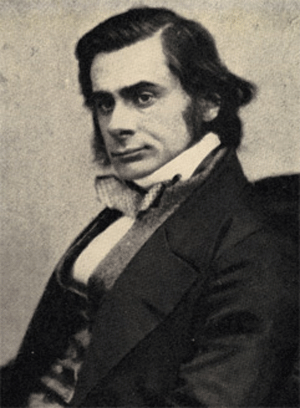
Huxley at 32
From 1860–63 Huxley developed his ideas, presenting them in lectures to working men, students and the general public, followed by publication. Also in 1862 a series of talks to working men was printed lecture by lecture as pamphlets, later bound up as a little green book; the first copies went on sale in December.[71] Other lectures grew into Huxley's most famous work Evidence as to Man's place in Nature (1863) where he addressed the key issues long before Charles Darwin published his Descent of Man in 1871.
Although Darwin did not publish his Descent of Man until 1871, the general debate on this topic had started years before (there was even a precursor debate in the 18th century between Monboddo and Buffon). Darwin had dropped a hint when, in the conclusion to the Origin, he wrote: "In the distant future... light will be thrown on the origin of man and his history".[72] Not so distant, as it turned out. A key event had already occurred in 1857 when Richard Owen presented (to the Linnean Society) his theory that man was marked off from all other mammals by possessing features of the brain peculiar to the genus Homo. Having reached this opinion, Owen separated man from all other mammals in a subclass of its own.[73] No other biologist held such an extreme view. Darwin reacted "Man...as distinct from a chimpanzee [as] an ape from a platypus... I cannot swallow that!"[74] Neither could Huxley, who was able to demonstrate that Owen's idea was completely wrong.
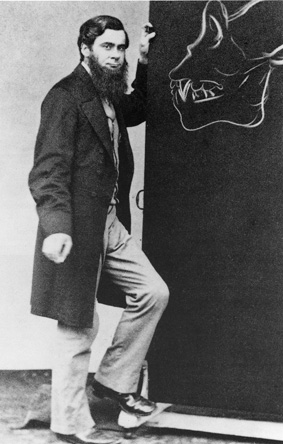
Huxley with sketch of a gorilla skull (c1870)
The subject was raised at the 1860 BA Oxford meeting, when Huxley flatly contradicted Owen, and promised a later demonstration of the facts. In fact, a number of demonstrations were held in London and the provinces. In 1862 at the Cambridge meeting of the B.A. Huxley's friend William Flower gave a public dissection to show that the same structures (the posterior horn of the lateral ventricle and hippocampus minor) were indeed present in apes. The debate was widely publicised, and parodied as the Great Hippocampus Question. It was seen as one of Owen's greatest blunders, revealing Huxley as not only dangerous in debate, but also a better anatomist.
Owen conceded that there was something that could be called a hippocampus minor in the apes, but stated that it was much less developed and that such a presence did not detract from the overall distinction of simple brain size.[75]
Huxley's ideas on this topic were summed up in January 1861 in the first issue (new series) of his own journal, the Natural History Review: "the most violent scientific paper he had ever composed".[48] This paper was reprinted in 1863 as chapter 2 of Man's Place in Nature, with an addendum giving his account of the Owen/Huxley controversy about the ape brain.[76] In his Collected Essays this addendum was removed.
The extended argument on the ape brain, partly in debate and partly in print, backed by dissections and demonstrations, was a landmark in Huxley's career. It was highly important in asserting his dominance of comparative anatomy, and in the long run more influential in establishing evolution amongst biologists than was the debate with Wilberforce. It also marked the start of Owen's decline in the esteem of his fellow biologists.
The following was written by Huxley to Rolleston before the BA meeting in 1861:
"My dear Rolleston... The obstinate reiteration of erroneous assertions can only be nullified by as persistent an appeal to facts; and I greatly regret that my engagements do not permit me to be present at the British Association in order to assist personally at what, I believe, will be the seventh public demonstration during the past twelve months of the untruth of the three assertions, that the posterior lobe of the cerebrum, the posterior cornu of the lateral ventricle, and the hippocampus minor, are peculiar to man and do not exist in the apes. I shall be obliged if you will read this letter to the Section" Yours faithfully, Thos. H. Huxley.[77]
During those years there was also work on human fossil anatomy and anthropology. In 1862 he examined the Neanderthal skull-cap, which had been discovered in 1857. It was the first pre-sapiens discovery of a fossil man, and it was immediately clear to him that the brain case was surprisingly large.[78]
Perhaps less productive was his work on physical anthropology, a topic which fascinated the Victorians. Huxley classified the human races into nine categories, and discussed them under four headings as: Australoid, Negroid, Xanthocroic and Mongoloid types. Such classifications depended mainly on appearance and anatomical characteristics.[79][80]
Natural selection
Huxley was certainly not slavish in his dealings with Darwin. As shown in every biography, they had quite different and rather complementary characters. Important also, Darwin was a field naturalist, but Huxley was an anatomist, so there was a difference in their experience of nature. Lastly, Darwin's views on science were different from Huxley's views. For Darwin, natural selection was the best way to explain evolution because it explained a huge range of natural history facts and observations: it solved problems. Huxley, on the other hand, was an empiricist who trusted what he could see, and some things are not easily seen. With this in mind, one can appreciate the debate between them, Darwin writing his letters, Huxley never going quite so far as to say he thought Darwin was right.
Huxley's reservations on natural selection were of the type "until selection and breeding can be seen to give rise to varieties which are infertile with each other, natural selection cannot be proved".[81][82] Huxley's position on selection was agnostic; yet he gave no credence to any other theory. Despite this concern about evidence, Huxley saw that if evolution came about through variation, reproduction and selection then other things would also be subject to the same pressures. This included ideas because they are invented, imitated and selected by humans: ‘The struggle for existence holds as much in the intellectual as in the physical world. A theory is a species of thinking, and its right to exist is coextensive with its power of resisting extinction by its rivals.’[83] This is the same idea as meme theory put forward by Richard Dawkins in 1976.[84]
Darwin's part in the discussion came mostly in letters, as was his wont, along the lines: "The empirical evidence you call for is both impossible in practical terms, and in any event unnecessary. It's the same as asking to see every step in the transformation (or the splitting) of one species into another. My way so many issues are clarified and problems solved; no other theory does nearly so well".[85]
Huxley's reservation, as Helena Cronin has so aptly remarked, was contagious: "it spread itself for years among all kinds of doubters of Darwinism".[86] One reason for this doubt was that comparative anatomy could address the question of descent, but not the question of mechanism.[87]
Pallbearer
Huxley was a pallbearer at the funeral of Charles Darwin on 26 April 1882.[88]
The X Club
Main article: X Club
In November 1864, Huxley succeeded in launching a dining club, the X Club, composed of like-minded people working to advance the cause of science; not surprisingly, the club consisted of most of his closest friends. There were nine members, who decided at their first meeting that there should be no more. The members were: Huxley, John Tyndall, J. D. Hooker, John Lubbock (banker, biologist and neighbour of Darwin), Herbert Spencer (social philosopher and sub-editor of the Economist), William Spottiswoode (mathematician and the Queen's Printer), Thomas Hirst (Professor of Physics at University College London), Edward Frankland (the new Professor of Chemistry at the Royal Institution) and George Busk, zoologist and palaeontologist (formerly surgeon for HMS Dreadnought). All except Spencer were Fellows of the Royal Society. Tyndall was a particularly close friend; for many years they met regularly and discussed issues of the day. On more than one occasion Huxley joined Tyndall in the latter's trips into the Alps and helped with his investigations in glaciology.[89][90][91]
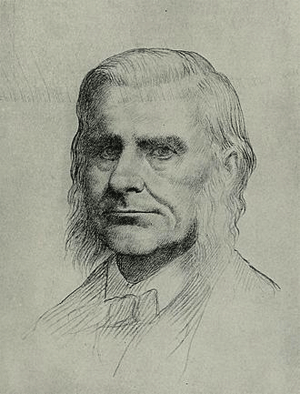
From the portrait of A. Legros.
There were also some quite significant X-Club satellites such as William Flower and George Rolleston, (Huxley protegés), and liberal clergyman Arthur Stanley, the Dean of Westminster. Guests such as Charles Darwin and Hermann von Helmholtz were entertained from time to time.[92]
They would dine early on first Thursdays at a hotel, planning what to do; high on the agenda was to change the way the Royal Society Council did business. It was no coincidence that the Council met later that same evening. First item for the Xs was to get the Copley Medal for Darwin, which they managed after quite a struggle.
The next step was to acquire a journal to spread their ideas. This was the weekly Reader, which they bought, revamped and redirected. Huxley had already become part-owner of the Natural History Review[93] bolstered by the support of Lubbock, Rolleston, Busk and Carpenter (X-clubbers and satellites). The journal was switched to pro-Darwinian lines and relaunched in January 1861. After a stream of good articles the NHR failed after four years; but it had helped at a critical time for the establishment of evolution. The Reader also failed, despite its broader appeal which included art and literature as well as science. The periodical market was quite crowded at the time, but most probably the critical factor was Huxley's time; he was simply over-committed, and could not afford to hire full-time editors. This occurred often in his life: Huxley took on too many ventures, and was not so astute as Darwin at getting others to do work for him.
However, the experience gained with the Reader was put to good use when the X Club put their weight behind the founding of Nature in 1869. This time no mistakes were made: above all there was a permanent editor (though not full-time), Norman Lockyer, who served until 1919, a year before his death. In 1925, to celebrate his centenary, Nature issued a supplement devoted to Huxley.[94]
The peak of the X Club's influence was from 1873 to 1885 as Hooker, Spottiswoode and Huxley were Presidents of the Royal Society in succession. Spencer resigned in 1889 after a dispute with Huxley over state support for science.[95] After 1892 it was just an excuse for the surviving members to meet. Hooker died in 1911, and Lubbock (now Lord Avebury) was the last surviving member.
Huxley was also an active member of the Metaphysical Society, which ran from 1869 to 1880.[96] It was formed around a nucleus of clergy and expanded to include all kinds of opinions. Tyndall and Huxley later joined The Club (founded by Dr. Johnson) when they could be sure that Owen would not turn up.[97]
Educational influence
When Huxley himself was young there were virtually no degrees in British universities in the biological sciences and few courses. Most biologists of his day were either self-taught, or took medical degrees. When he retired there were established chairs in biological disciplines in most universities, and a broad consensus on the curricula to be followed. Huxley was the single most influential person in this transformation.
School of Mines and Zoology
In the early 1870s the Royal School of Mines moved to new quarters in South Kensington; ultimately it would become one of the constituent parts of Imperial College London. The move gave Huxley the chance to give more prominence to laboratory work in biology teaching, an idea suggested by practice in German universities.[28] In the main, the method was based on the use of carefully chosen types, and depended on the dissection of anatomy, supplemented by microscopy, museum specimens and some elementary physiology at the hands of Foster.
The typical day would start with Huxley lecturing at 9am, followed by a program of laboratory work supervised by his demonstrators.[98] Huxley's demonstrators were picked men—all became leaders of biology in Britain in later life, spreading Huxley's ideas as well as their own. Michael Foster became Professor of Physiology at Cambridge; E. Ray Lankester became Jodrell Professor of Zoology at University College London (1875–91), Professor of Comparative Anatomy at Oxford (1891–98) and Director of the Natural History Museum (1898–1907); S.H. Vines became Professor of Botany at Cambridge; W.T. Thiselton-Dyer became Hooker's successor at Kew (he was already Hooker's son-in-law!); T. Jeffery Parker became Professor of Zoology and Comparative Anatomy at University College, Cardiff; and William Rutherford[99] became the Professor of Physiology at Edinburgh. William Flower, Conservator to the Hunterian Museum, and THH's assistant in many dissections, became Sir William Flower, Hunterian Professor of Comparative Anatomy and, later, Director of the Natural History Museum.[34] It's a remarkable list of disciples, especially when contrasted with Owen who, in a longer professional life than Huxley, left no disciples at all. "No one fact tells so strongly against Owen... as that he has never reared one pupil or follower".[100]
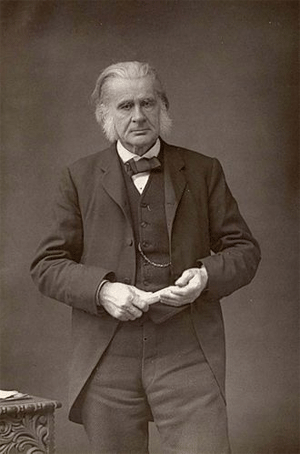
Photograph of Huxley (c. 1890)
Huxley's courses for students were so much narrower than the man himself that many were bewildered by the contrast: "The teaching of zoology by use of selected animal types has come in for much criticism";[101] Looking back in 1914 to his time as a student, Sir Arthur Shipley said "Darwin's later works all dealt with living organisms, yet our obsession was with the dead, with bodies preserved, and cut into the most refined slices".[102] E.W MacBride said "Huxley... would persist in looking at animals as material structures and not as living, active beings; in a word... he was a necrologist.[103] To put it simply, Huxley preferred to teach what he had actually seen with his own eyes.
This largely morphological program of comparative anatomy remained at the core of most biological education for a hundred years until the advent of cell and molecular biology and interest in evolutionary ecology forced a fundamental rethink. It is an interesting fact that the methods of the field naturalists who led the way in developing the theory of evolution (Darwin, Wallace, Fritz Müller, Henry Bates) were scarcely represented at all in Huxley's program. Ecological investigation of life in its environment was virtually non-existent, and theory, evolutionary or otherwise, was at a discount. Michael Ruse finds no mention of evolution or Darwinism in any of the exams set by Huxley, and confirms the lecture content based on two complete sets of lecture notes.[104]
Since Darwin, Wallace and Bates did not hold teaching posts at any stage of their adult careers (and Műller never returned from Brazil) the imbalance in Huxley's program went uncorrected. It is surely strange that Huxley's courses did not contain an account of the evidence collected by those naturalists of life in the tropics; evidence which they had found so convincing, and which caused their views on evolution by natural selection to be so similar. Desmond suggests that "[biology] had to be simple, synthetic and assimilable [because] it was to train teachers and had no other heuristic function".[105] That must be part of the reason; indeed it does help to explain the stultifying nature of much school biology. But zoology as taught at all levels became far too much the product of one man.
Huxley was comfortable with comparative anatomy, at which he was the greatest master of the day. He was not an all-round naturalist like Darwin, who had shown clearly enough how to weave together detailed factual information and subtle arguments across the vast web of life. Huxley chose, in his teaching (and to some extent in his research) to take a more straightforward course, concentrating on his personal strengths.

